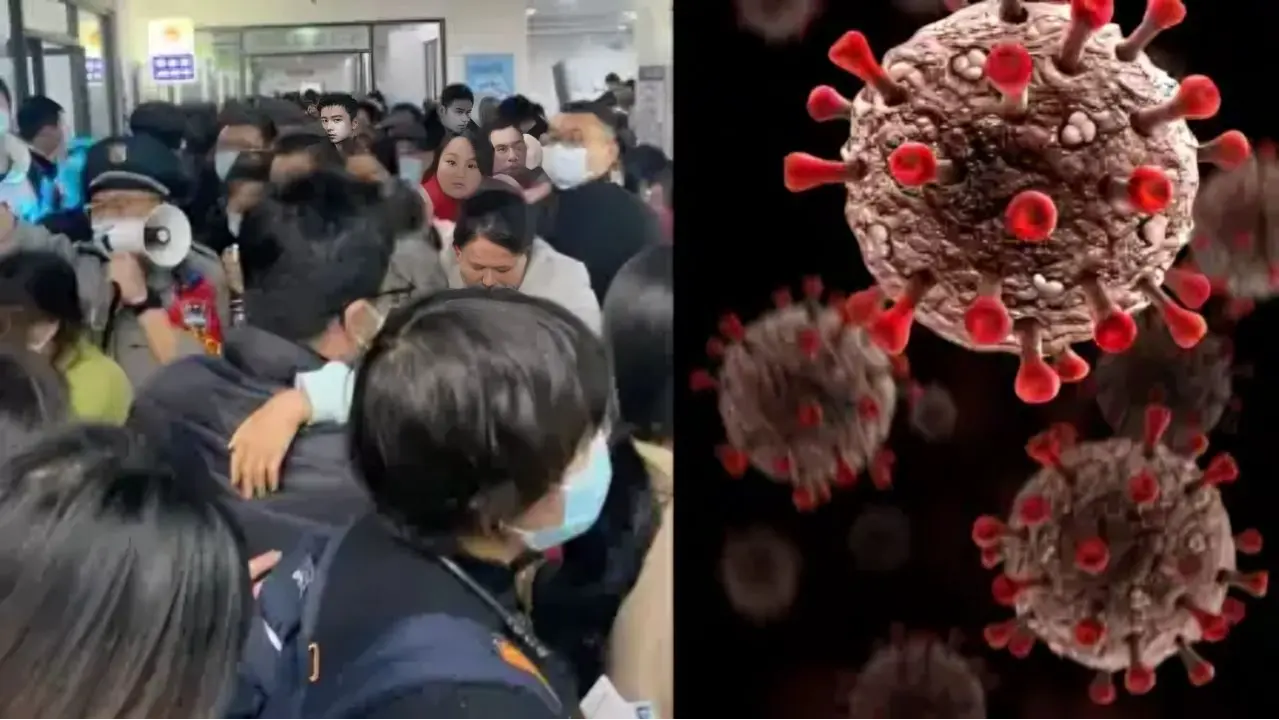Updated 6 January 2025 at 10:19 IST
HMPV Outbreak in China: Symptoms, Transmission, and Key Facts You Need to Know
HMPV typically causes flu-like symptoms, has the potential to cause severe respiratory complications, particularly in children and other vulnerable populations.
- Health News
- 6 min read

China is currently experiencing a significant increase in cases of human metapneumovirus (HMPV), raising concerns about the potential for another public health crisis following the COVID-19 pandemic. Reports, along with social media posts, highlight overcrowded hospitals, with some individuals speculating that multiple viruses are circulating, including HMPV, influenza A, Mycoplasma pneumoniae, and even COVID-19.
HMPV, which typically causes flu-like symptoms, has the potential to cause severe respiratory complications, particularly in children and other vulnerable populations. This surge has prompted health experts to closely monitor the situation. Let’s delve deeper into the details of this respiratory virus.
What is HMPV and Why is it Making Headlines in China?
Human Metapneumovirus (HMPV) is a respiratory virus that can cause infections in the upper and lower respiratory tracts. It affects people of all ages, though young children, the elderly, and individuals with weakened immune systems are at higher risk. First identified in 2001, it has recently garnered attention due to a surge in cases in certain regions, particularly China. Health experts are monitoring the situation as cases increase, and concerns about its impact on public health are rising.
Symptoms of HMPV

HMPV symptoms are similar to those of the flu and other common respiratory infections. They include:
Advertisement
- Cough
- Fever
- Nasal congestion
- Shortness of breath
In severe cases, HMPV can lead to more serious complications like:
- Bronchitis
- Pneumonia
Incubation and Duration
The virus typically has an incubation period of three to six days. The duration of symptoms can vary depending on the severity of the infection. Some people may recover quickly, while others may experience prolonged symptoms, particularly those with pre-existing health conditions.
Advertisement
How HMPV Spreads
- Human Metapneumovirus (HMPV) spreads in several ways, similar to other respiratory infections. The main methods of transmission include:
- Respiratory Droplets: When an infected person coughs or sneezes, tiny droplets containing the virus are released into the air and can be inhaled by those nearby.
- Close Personal Contact: Direct contact, such as shaking hands or touching someone who is infected, can transfer the virus.
- Contaminated Surfaces: The virus can survive on surfaces for a period of time. Touching these surfaces and then touching your mouth, nose, or eyes can lead to infection.
Who Is Most at Risk for HMPV?
- Certain individuals are more vulnerable to severe illness from HMPV, particularly:
- Young Children: Their immune systems are still developing, making them more susceptible to infections like HMPV.
- Older Adults: As the immune system weakens with age, older adults face a higher risk of complications from HMPV.
- Immunocompromised Individuals: Those with weakened immune systems, such as people undergoing chemotherapy or with chronic diseases, are at greater risk of severe infection.
How to Prevent HMPV
Preventing Human Metapneumovirus (HMPV) involves following standard precautions to avoid the spread of respiratory viruses. Here are key steps to reduce the risk:
1. Practice Good Hand Hygiene
Wash hands regularly with soap and water for at least 20 seconds, especially after coughing, sneezing, or touching surfaces.
If soap and water aren't available, use a hand sanitizer with at least 60% alcohol.
2. Avoid Touching Your Face
Resist touching your face, particularly your eyes, nose, and mouth, with unwashed hands to prevent the virus from entering the body.
3. Maintain Physical Distance
Stay at least 6 feet away from individuals showing symptoms of respiratory illness, such as coughing or sneezing.
4. Disinfect High-Touch Surfaces
Regularly clean and disinfect frequently touched surfaces like doorknobs, light switches, remote controls, and children's toys.
What to Do if You Experience HMPV Symptoms
If you start experiencing symptoms associated with HMPV, such as coughing, congestion, and fever, it's crucial to follow these measures to avoid spreading the virus:
1. Cover Your Mouth and Nose
Use a tissue or the elbow of your arm when sneezing or coughing to prevent droplets from spreading into the air and potentially infecting others.
2. Wash Your Hands Frequently
Practice thorough handwashing with soap and water for at least 20 seconds, especially after coughing, sneezing, or blowing your nose.
3. Avoid Sharing Personal Items
Do not share cups, utensils, or personal hygiene items, as the virus can spread through saliva and nasal secretions.
4. Stay Home When Sick
If you're feeling unwell, it's best to stay home to rest and recover, while also preventing the virus from spreading to others in public spaces.
Treatment and Vaccine for HMPV
Currently, there is no specific antiviral treatment or vaccine available for Human Metapneumovirus (HMPV). The management of HMPV infection is primarily supportive, aimed at easing symptoms and preventing complications. Patients may receive care such as fluids, rest, and medications to relieve pain, fever, and congestion, but no targeted treatment exists at this time.
Comparing HMPV to COVID-19
HMPV and COVID-19 are both respiratory viruses, causing similar symptoms such as:
- Cough
- Fever
- Congestion
- Sore throat
- Shortness of breath
Both viruses spread primarily through respiratory droplets. In severe cases, both can lead to hospitalization, particularly in vulnerable populations like the elderly or those with weakened immune systems.
However, there are key differences between the two:
Seasonality: HMPV typically peaks in the winter and spring months, while COVID-19 can spread year-round due to the emergence of new variants.
Impact of COVID-19 Lockdowns: After the COVID-19 restrictions were lifted, studies indicated that HMPV cases tripled in some regions. The significant drop in viral exposure during the lockdowns likely reduced the population's immunity, which, when precautions were eased, led to a surge in respiratory infections like HMPV.
These differences in behavior and seasonality highlight how various respiratory viruses can fluctuate based on environmental and societal factors.
Precautions for Traveling Across Asia
Practice Frequent Hand Hygiene: To reduce the risk of virus transmission, it's essential to wash your hands regularly with soap and water, especially after touching potentially contaminated surfaces. Hand sanitizers with at least 60% alcohol can also be a good alternative when soap and water are unavailable.
Avoid Close Contact with Infected Individuals: It is crucial to minimize direct interaction with individuals who have suspected or confirmed cases of Human Metapneumovirus (HMPV) or other contagious illnesses. Avoid close proximity, especially if the person is coughing, sneezing, or showing signs of illness.
Regular Disinfection of High-Touch Surfaces: Viruses can survive on surfaces for extended periods. Ensure that you disinfect frequently touched surfaces, such as door handles, light switches, computer keyboards, and mobile devices. Use disinfectant wipes or sprays that are proven to kill germs and viruses.
Ensure Proper Ventilation: In both indoor and shared spaces, proper air circulation is essential. Open windows when possible or use air purifiers to help reduce the presence of airborne viruses, particularly in crowded or enclosed environments.
Use Masks Appropriately: Wearing masks can be a vital protective measure, especially in crowded places or areas with higher risks of virus exposure. Masks should be worn properly—covering both the nose and mouth—to effectively reduce the risk of airborne virus transmission.
Avoid Crowded Areas: Reducing visits to highly crowded places, particularly during peak virus season or local outbreaks, can significantly lower your chances of infection. Opt for less crowded alternatives when possible.
Published By : Medha Singh
Published On: 3 January 2025 at 19:09 IST
